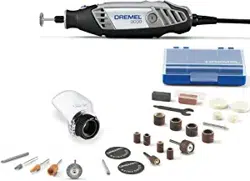Loading ...
Loading ...
Loading ...

12
I
t is this high speed, along with its compact
size and wide variety of special accessories
and attachments, that makes the Rotary Tool
differ ent from other tools. The speed enables it
to do jobs low speed tools cannot do, such as
cutting hardened steel, en graving glass, etc.
Getting the most out of your Rotary Tool is a
matter of learning how to let this speed work
for you. To learn about more uses and the
versatility of Dremel accessories and
attachments refer to this Owner's Manual or
check our website at www.Dremel.com.
Using the Rotary Tool
The first step in learning to use the Rotary Tool
is to get the “feel” of it. Hold it in your hand and
feel its weight and balance.
Always hold the tool
away from your face.
Accessories can be
damaged during
handling, and can fly
apart as they come up
to speed. This is not
common, but it does happen.
Whenever you hold the
tool, be careful not to
cover the air vents with your hand. This
blocks the air flow and causes the motor to
overheat.
F
or best control in close work, grip the Rotary
Tool like a pencil between your thumb and
forefinger (Figure A).
The “Golf Grip” method of holding the tool is
used for more aggressive operations such as
grinding a flat surface or using cutoff wheels
(Figure B).
Practice on scrap materials first to see how the
Rotary Tool's high speed action performs.
Keep in mind that the work is done by the
speed of the tool and by the accessory in the
collet. You should not lean on or push the tool
during use.
Instead, lower the spinning accessory lightly to
the work and allow it to touch the point at
which you want cutting (or sanding or etching,
etc.) to begin. Con centrate on guiding the tool
over the work using very little pressure from
your hand. Allow the accessory to do the work.
Usually, it is best to make a series of passes
with the tool rather than attempt to do all the
work in one pass. To make a cut, for example,
pass the tool back and forth over the work,
much as you would a small paint brush. Cut a
little material on each pass until you reach the
desired depth. For most work, the gentle touch
is best. With it, you have the best control, are
less likely to make errors, and will get the most
effi cient work out of the accessory.
FIG. A
FIG. B
Questions or Problems? Call 1-800-437-3635
or check our website at www.Dremel.com
1600A011JA.qxp_100 200 3000 4/12/17 12:55 PM Page 12
Loading ...
Loading ...
Loading ...
